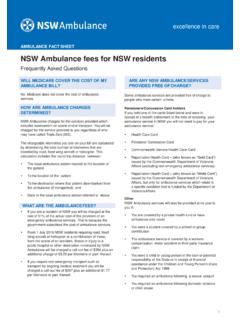Transcription of DAY OF THE ROSES NEW HELICOPTER BASE ON …
1 SIRENS 1 76 ISSUESEVENTY SIXDAY OF THE ROSESNEW HELICOPTER BASEON STATION WITH DRUMMOYNEHEALTHY WORKPLACEFEBRUARY 20172 NSW AMBULANCEOn a sunny summer s day in Granville, thousands of people gathered at Bold Street Bridge near the centre of town where, 40 years ago, history was made A contingent of helicopters from our emergency service organisations conducted a fly over while victims and their families threw 83 ROSES onto the tracks where the train had derailed, a commemoration to each person who died. Chief Executive Dominic Morgan, Duty Operations Manager Josh Payne and Deputy Director of Operations Joel Bardsley joined with local paramedics, emergency service colleagues and relatives of the victims, to acknowledge the significance of the day. Retired NSW Ambulance paramedics who assisted in the rescue effort were also present at the memorial; Barry Gobbe, Ken Peterson and Noel Boys. BackgroundOn 18 January 1977 at am, an east-travelling train derailed while taking a left hand curve near the Granville railway station.
2 After becoming derailed, the train struck the Bold Street Bridge, demolishing all eight steel foundations of the supporting trestle. The train then came to a rest on its right side, 67 metres ahead. During the crash, the train also sheared a steel electric power line from its base, causing its mast to tear through the side walls and detach the roof of the first rail carriage which was still in tow. Another carriage was also derailed, but came to rest clear of the bridge and suffered little damage. Carriages three and four stopped directly under the bridge, and tragically within seconds, the bridge broke into two sections and a combined weight of 570 tonnes collapsed onto these carriages, along with the four vehicles that were on top of the bridge at the operational responseNSW Ambulance paramedics arrived first on scene as activated by the Sydney Metropolitan Disaster Medical Program (SMDMP) and casualities were immediately evacuated to nearby hospitals. Fire & Rescue NSW arrived Australia s worst rail disaster occurred at Granville, Sydney on 18 January 1977 when a packed commuter train derailed and collided with an overhead rail bridge, killing 83 people and injuring 210.
3 Last month, NSW Ambulance recognised the 40th anniversary of the event, and the brave paramedics who helped to rescue and treat hundreds of patients. Following the events of 1977, retired paramedic Barry Gobbe wrote a book, outlining his experiences while working as a first responder during Granville. Here he explains what it was like when he arrived: I was the first to enter under the bridge from the north/western side on my own. No one else was there; I stood all alone in amazement. There was no carriage wall and all commuters were visible; just bent over slouched in their seats. No one seemed to be alive; their faces pushed down into their newspaper on their laps. They didn t know what hit them. I was surrounded by a peaceful feeling, only the sound of cracking timber due to the bridge still settling. No one was moaning; no one was making a sound, I find myself in a dark, misty tunnel and now all these years later, I find myself tearing up, remembering those feelings I had forgotten.
4 Australia s worst rail disaster occurred at Granville, Sydney on 18 January 1977 when a packed commuter train derailed and collided with an overhead rail bridge, killing 83 people and injuring 210. Last month, NSW Ambulance recognised the 40th anniversary of the event, and the brave paramedics who helped to rescue and treat hundreds of 3 GRANVILLE 40th ANNIVERSARYL essons learnedSince Granville, there have been a variety of changes and developments to how emergency services and hospitals respond to disasters. The outcome of the Granville disaster inquiry was tabled in NSW Parliament by Premier Neville Wran, the result published in The Canberra Times on 1 June 1977 (above).In the wake of the disaster, an article was written by Dr John Boger, Co-ordinator, Public Health & Preventative Medicine services for the NSW Ambulance Service Call magazine who said the response was well coordinated, due largely to a simulated exercise which had been conducted for emergency services just two months earlier.
5 Shortly after and provided forcible entry tools as well as ladders to access the crash site. Two medical teams and three general practitioners were brought in within the first half hour to begin the triage process and seven fully equipped medical teams were at the site within two hours. Eighty-seven doctors and nurses were known to be onsite, and remained there until the last body was removed some 30 hours later. At the hospitals, specialists reported in to provide immediate emergency surgery and volunteers donated food, drink and 1800 units of blood. Forty-one ambulances were available by mid-morning with 85 in total sent to the scene. Army helicopters were able to land 50 metres away and took the two most critical casualties directly to hospital. There were 53 fire fighters and 250 police officers present to assist with the rescue, as well as controlling the large crowd of onlookers and dealing with the looting of rescue equipment. Injuries to patientsThe main medical concern during the rescue was crush syndrome, where the compressive forces exert pressure on the body which damages muscle tissue, causing cell membranes to breach and spill out their contents of muscle protein, myoglobin and potassium while calcium enters the cell.
6 The longer the patient is trapped, the greater the chance of the crush syndrome and other injuries developing. You can read more about this on page 10. Extrication issuesThere were a number of issues that meant patient extrication was difficult and dangerous: The collapse of the bridge divided rescue efforts, meaning some rescuers approached the scene from the east and west of the bridge, while others came from the north and south carriages. Because the bridge had collapsed in sections, it could not be removed intact and had to be cut at the site and then removed, which was time-consuming. Telephone connections to Granville were cut, and although radio communication was utilised, it was hampered by the nature of the site, with the large amount of steel, overhead rail cables and transmission equipment. The scene was not rendered safe before rescuers and clinicians entered. The bridge had not been removed and shifted several times during the operation. Butane gas was found to be escaping from cylinders and there were unstable electricity lines overhead which hadn t been disconnected.
7 There was also an official order issued by a lead rescue officer, stating that once a rescuer was with their patient, they could not leave until the patient was pulled from the NSW AMBULANCE Those who were there marveled at the ease with which the various government and voluntary agencies .. worked together tirelessly in appalling and dangerous conditions, he Boger wrote that Granville occurred just two months after a simulated exercise ( Westmed ) was held, featuring a similar number of casualties. He said it was: .. clear that Granville s surviving victims and the relatives and friends of the dead were fortunate that the local services had recently been exercised in how to cope with an actual situation. The experience meant that while there was an abundance of help quickly available - the activities on the site were wonderfully coordinated by the acknowledged team leader - the NSW Police Force .Retired Paramedic Keith Smith said Granville represented a major turning point for NSW Ambulance in terms of emergency management and managing large amounts of patients.
8 It was the first really big incident and we learned so much about emergency management and how to manage large amounts of patients. We really came forward from that day. Not just GRANVILLE 40th ANNIVERSARYI witnessed the extrication of the last living survivor, who was the brother-in-law of one of the officers on our shift. I got home about that night. I was pretty much a spent unit by Ambulance Service but emergency management in general. It s more structured now. Mr Smith was part of NSW Ambulance for 43 years and was on shift during the Granville incident. He said at the time of his retirement: I was the original controller in the control room of the Granville rail disaster. When we changed over at lunchtime, our whole day shift took some cars out to the scene. I witnessed the extrication of the last living survivor, who was the brother-in-law of one of the officers on our shift. I got home about that night. I was pretty much a spent unit by then. Clinical developmentsAs mentioned, the Granville rail disaster was the first time that significant crush syndrome was seen in Australia and lessons were learnt from the incident regarding the early management of crush syndrome.
9 NSW Ambulance paramedics are now acutely aware of the potential of crush injury syndrome in trapped patients and the specific clinical management required (Protocol T 15 Trapped Patient). Also, there are now more highly trained and skilled paramedics in operation and all emergency services are better equipped than ever before with new technology such as GPS, satellite phones, breathing apparatus, safety equipment, portable ECG monitors and defibrillators. Article completed with contribution from Paramedic Maggie 5 GRANVILLE 40th ANNIVERSARYS ince Granville, there have been a variety of changes and developments to how emergency services and hospitals respond to disasters. 6 NSW AMBULANCENEW SYDNEY HELICOPTER BASENEW SYDNEY HELICOPTER BASEUp, up and away! What an exciting time it s been for Health emergency and Aeromedical services , with the launch of the new Toll & NSW Ambulance Rescue HELICOPTER Service at Bankstown Aerodrome. The official launch of the HELICOPTER contract occurred on Friday, 13 February.
10 Former NSW Minister for Health Jillian Skinner, joined with the Chief Executive Dominic Morgan, representatives from Toll and NSW Ambulance and attending journalists to showcase the new base. Former Minister Skinner spoke about the importance of this partnership. The new HELICOPTER Retrieval Network will improve coverage for rural, regional and remote NSW and deliver a world-class modern HELICOPTER fleet for NSW patients, no matter where they live, she the NSW Government s Reform On Tuesday, 10 January, the first mission for our brand new fleet of Toll & NSW Ambulance helicopters occurred with the Agusta Westland 139 (AW139) taking to the sky to treat and transport a patient, the first of many to come. Social mediaThe new base also has its own social media pages, which are operated jointly by Toll and NSW Ambulance. Make sure you re following the accounts for the latest updates:Facebook: @TollAirAmbulanceTwitter: @tollambulanceSIRENS 7 NEW SYDNEY HELICOPTER BASENEW SYDNEY HELICOPTER BASEPlan for Aeromedical (Rotary Wing) Retrieval services in NSW, the state has been divided into two distinct aeromedical retrieval zones the Southern Zone (Sydney - Bankstown, Wollongong and Orange HELICOPTER Bases) operated by Toll Group and the Northern Zone (Newcastle, Tamworth and Lismore HELICOPTER Bases) operated by Northern NSW HELICOPTER Rescue Service Pty operators have been successful in securing the contracts for these aeromedical operations: Toll has been appointed the Southern Zone service provider; Westpac Rescue has been appointed the Northern Zone service Toll & NSW Ambulance Rescue HELICOPTER fleet is made up of eight bigger AW139 helicopters, which will assist NSW Ambulance to reach patients even further away from NSW Ambulance bases, quicker than ever before.






